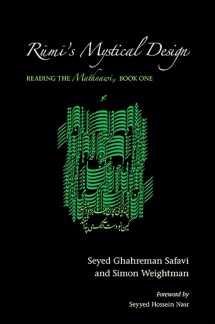
Rumi's Mystical Design: Reading the Mathnawi, Book One (SUNY series in Islam)
ISBN-13:
9781438427966
ISBN-10:
1438427964
Edition:
Illustrated
Author:
Seyed Ghahreman Safavi, Simon Weightman
Publication date:
2009
Publisher:
State University of New York Press
Format:
Paperback
290 pages
Category:
History
,
Islam
,
Mysticism
,
Other Religions, Practices & Sacred Texts
FREE US shipping
Book details
ISBN-13:
9781438427966
ISBN-10:
1438427964
Edition:
Illustrated
Author:
Seyed Ghahreman Safavi, Simon Weightman
Publication date:
2009
Publisher:
State University of New York Press
Format:
Paperback
290 pages
Category:
History
,
Islam
,
Mysticism
,
Other Religions, Practices & Sacred Texts
Summary
Rumi's Mystical Design: Reading the Mathnawi, Book One (SUNY series in Islam) (ISBN-13: 9781438427966 and ISBN-10: 1438427964), written by authors
Seyed Ghahreman Safavi, Simon Weightman, was published by State University of New York Press in 2009.
With an overall rating of 4.2 stars, it's a notable title among other
History
(Islam, Mysticism, Other Religions, Practices & Sacred Texts ) books. You can easily purchase or rent Rumi's Mystical Design: Reading the Mathnawi, Book One (SUNY series in Islam) (Paperback) from BooksRun,
along with many other new and used
History
books
and textbooks.
And, if you're looking to sell your copy, our current buyback offer is $0.3.
Description
Reveals the sophisticated design of Rumī’s Mathnawī, showing that this seemingly unstructured work both describes and functions as spiritual training.
This landmark book reveals the structure of Rumī’s thirteenth-century classic, the Mathnawī. A beloved collection of 25,000 picturesque, alliterative verses full of anecdotes and parables on what appear to be loosely connected themes, the Mathnawī presents itself as spontaneous and unplanned. However, as Seyed Ghahreman Safavi and Simon Weightman demonstrate, the work has a sophisticated design that deliberately hides the spiritual so that readers, as seekers, have to find it for themselves—it is not only about spiritual training, it is spiritual training. Along with a full synoptic reading of the whole of Book One, the authors provide material on Rumī’s life, his religious position, and his literary antecedents. Safavi and Weightman have provided readers, students, and scholars with a valuable resource: the guide that they wished they had had prior to their own reading of this great spiritual classic.
“This is possibly the best explanation of the significance of the entire work ever written, certainly so in English. The authors bring out dimensions of the ornate and sophisticated structure of the Mathnawī, of which other authors have had at best only inklings.” — William C. Chittick, author of The Sufi Doctrine of Rumī
This landmark book reveals the structure of Rumī’s thirteenth-century classic, the Mathnawī. A beloved collection of 25,000 picturesque, alliterative verses full of anecdotes and parables on what appear to be loosely connected themes, the Mathnawī presents itself as spontaneous and unplanned. However, as Seyed Ghahreman Safavi and Simon Weightman demonstrate, the work has a sophisticated design that deliberately hides the spiritual so that readers, as seekers, have to find it for themselves—it is not only about spiritual training, it is spiritual training. Along with a full synoptic reading of the whole of Book One, the authors provide material on Rumī’s life, his religious position, and his literary antecedents. Safavi and Weightman have provided readers, students, and scholars with a valuable resource: the guide that they wished they had had prior to their own reading of this great spiritual classic.
“This is possibly the best explanation of the significance of the entire work ever written, certainly so in English. The authors bring out dimensions of the ornate and sophisticated structure of the Mathnawī, of which other authors have had at best only inklings.” — William C. Chittick, author of The Sufi Doctrine of Rumī


We would LOVE it if you could help us and other readers by reviewing the book
Book review

Congratulations! We have received your book review.
{user}
{createdAt}
by {truncated_author}


